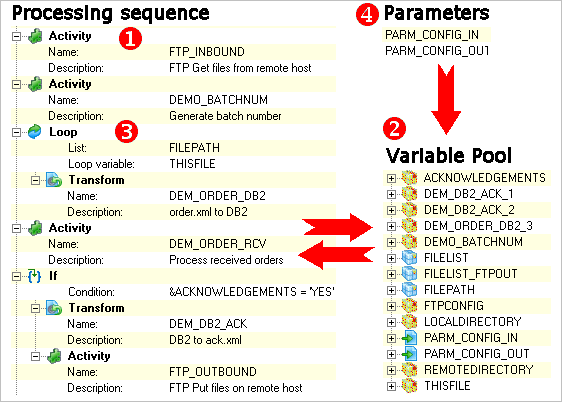3.1 Anatomy of a Processing Sequence
The following screen picture shows some of the major concepts supporting a Processing Sequence. The numbers refer to the following paragraphs that elaborate on the highlighted concepts:

1. Activities and Transformation Maps provide the business functionality
The main purpose of Processing Sequences in LANSA Composer is to run one or more Activities and Transformation Maps in a defined order. The simplest Processing Sequences might simply perform a single Activity or Transformation.

More typically a Processing Sequence will combine one or more Activities and/or Transformation Maps in order to complete a business process. Refer to 3.1.1 Activities and Transformation Maps for information.
2. Variables provide Communication between Activities
In any non-trivial Processing Sequence, it will probably be necessary to communicate information between the Activities and Transformation Maps that make up the Processing Sequences. LANSA Composer provides the Processing Sequence variable pool for this purpose. Refer to 3.1.2 Variables and 3.1.3 Built-in Variables for details.
3. Processing Sequence Directives provide Powerful Orchestration
In order to perform complex multi-step business processes, it is not enough to simply string a sequence of Activities or Transformations together. You need some means of controlling their execution with loops, conditioning and other constructs.

LANSA Composer provides a set of Processing Sequence Directives for this purpose. Refer to 3.1.4 Processing Directives for more information.
4. Processing sequence parameters for Run-Time Flexibility
Processing sequences can receive parameters that become variables in the variable pool. The use of parameters enhances the flexibility of Processing Sequences by permitting the use of a single Processing Sequence with different inputs to satisfy multiple variations of a business process case. Refer to 3.1.5 Parameters for more information.
Also see